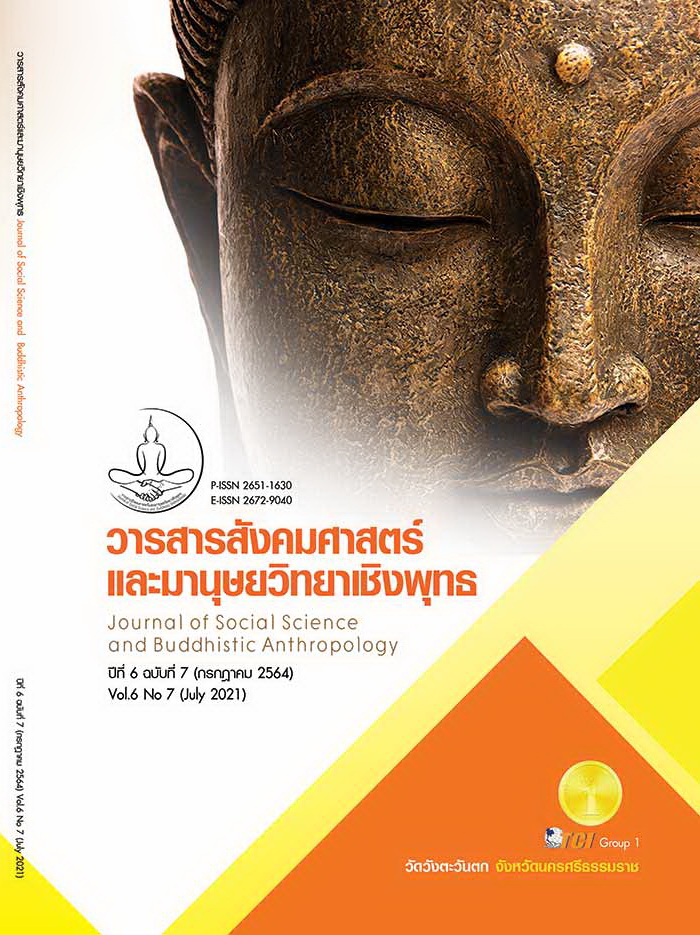การส่งเสริมเครือข่ายจิตอาสาของพระสงฆ์ เขตภาคกลางตอนล่างในประเทศไทย
คำสำคัญ:
การส่งเสริม, เครือข่ายจิตอาสา, พระสงฆ์, ภาคกลางตอนล่างบทคัดย่อ
บทความวิจัยนี้มีวัตถุประสงค์เพื่อ 1) ศึกษาปัจจัยที่เกี่ยวข้องกับการส่งเสริมเครือข่ายจิตอาสา 2) ศึกษารูปแบบการดำเนินงานการส่งเสริมเครือข่ายจิตอาสา 3) สร้างรูปแบบแนวปฏิบัติที่ดี ใช้ระเบียบวิธีการวิจัยแบบผสมผสานวิธี การวิจัยเชิงปริมาณ กลุ่มตัวอย่างที่เป็นพระสงฆ์ จำนวน 400 รูป เลือกแบบกำหนดโควต้า วิเคราะห์ข้อมูลโดยค่าเฉลี่ย ส่วนเบี่ยงเบนมาตรฐาน ทดสอบสมมติฐานการวิเคราะห์การถดถอยเชิงเส้นแบบพหุคูณ ส่วนการวิจัยเชิงคุณภาพ โดยใช้การสัมภาษณ์เชิงลึก กับผู้ให้ข้อมูลสำคัญ จำนวน 32 รูป/คน การสนทนากลุ่มเฉพาะ จำนวน 18 รูป/คน ใช้เทคนิคการวิเคราะห์เนื้อหาประกอบบริบท ผลการวิจัยพบว่า 1) ปัจจัยที่เกี่ยวข้อง ประกอบด้วย 1.1) เจตคติ โดยรวม อยู่ในระดับมาก ( = 4.09) 1.2) ปัจจัยที่เกี่ยวข้อง โดยรวม อยู่ในระดับมาก (
= 3.99) 1.3) พฤติกรรมเชิงจริยธรรม โดยรวม อยู่ในระดับมาก (
= 4.09) 1.4) ปัจจัยที่เกี่ยวข้อง ทดสอบด้วยค่าถดถอยพหุคูณเชิงเส้นตรง ระหว่างตัวแปรอิสระกับตัวแปรตาม โดยรวม ได้แก่ ปัจจัยการรับรู้มุมมองร่วมกัน (X1) (ß = .264) ปัจจัยการมีส่วนร่วม (X4) (ß = .104) ปัจจัยการเสริมสร้าง (X5) (ß = .095) ปัจจัยการพึ่งพาอาศัยกันและกัน (X6) มีความสัมพันธ์เชิงเส้นตรงกับตัวแปรตาม (ปัจจัยที่เกี่ยวข้องกับพฤติกรรมเชิงจริยธรรม) (F = 132.725; p - Value = 0.001) 2) การดำเนินงาน พบว่า มี 5 ขั้น ได้แก่ ขั้นที่ 1 กำหนดเป้าหมาย ขั้นที่ 2 กำหนดคุณลักษณะ ขั้นที่ 3 เน้นกระบวนการทำงานเพื่อชุมชน ขั้นที่ 4 มุ่งถ่ายทอดความรู้เพื่อผู้อื่น และขั้นที่ 5 สะท้อนคิดผลการปฏิบัติงาน 3) รูปแบบ ประกอบด้วย 3.1) ด้านการประยุกต์การส่งเสริมเชิงพุทธบูรณาการ 3.2) ด้านการขับเคลื่อนการส่งเสริม 3.3) ด้านการมีส่วนร่วมและทุนทางสังคม
เอกสารอ้างอิง
เกษฎา ผาทอง และคณะ. (2562). บทบาทของพระสงฆ์กับการเสริมสร้างวัฒนธรรมทางการเมืองในพื้นที่ประเทศกัมพูชา ลาว พม่า และไทย. วารสารสันติศึกษาปริทรรศน์ มจร, 7(6), 1662-1676.
จิตอาสาศรีปทุม. (2557). จิตอาสา หนทางอยู่ร่วมกันในสังคม. เรียกใช้เมื่อ 15 กรกฎาคม 2563 จาก https://sites.google.com/site/citxasasripthum2557/cit-xasa-hrux-cit-satharna
นพมาศ ธีรเวคิน. (2542). บทความเรื่องจิตวิทยา สังคมกับชีวิต. รวบรวมจัดพิมพ์โดย นพมาศ ธีรเวคิน. (พิมพ์ครั้งที่ 3). กรุงเทพมหานคร: โรงพิมพ์มหาวิทยาลัยธรรมศาสตร์.
ประชาชาติธุรกิจ. (2563). ในหลวงโปรดเกล้าฯ พระราชทานชื่อจิตอาสาและภาพการ์ตูนฝีพระหัตถ์จิตอาสาใหม่. เรียกใช้เมื่อ 12 กันยายน 2563 จาก https://www.prachachat.net/general/news-333521
พระจํานงค์ ผมไผ และคณะ. (2563). วัดกับการส่งเสริมการท่องเที่ยวบนเส้นทางลุ่มน้ำโขง. วารสารสังคมศาสตร์และมานุษยวิทยาเชิงพุทธ, 5(5), 158-170.
พระมหาโยธิน โยธิโก และคณะ. (2563). การสร้างความสมดุลและการรักษาต้นทุนทางธรรมชาติเชิงพุทธ ของเครือข่ายป่าชุมชนในภาคตะวันออกเฉียงเหนือ. วารสารสังคมศาสตร์และมานุษยวิทยาเชิงพุทธ, 5(12), 30-43.
ไพศาล สรรสรวิสุทธิ์. (2550). การพัฒนาชุมชน. กรุงเทพมหานคร: รัฐศาสตร์สาส์น.
มติชนรายวัน. (2563). เรียงคนมาเป็นข่าว. เรียกใช้เมื่อ 15 กรกฎาคม 2563 จาก https://www.matichon.co.th/politics/news_2622215
วิกิพีเดีย สารานุกรมเสรี. (2563). ภาคกลาง (ประเทศไทย). เรียกใช้เมื่อ 15 กรกฎาคม 2563 จาก https://th.wikipedia.org/wiki/ภาคกลาง_(ประเทศไทย)
สำนักงานคณะกรรมการพัฒนาการเศรษฐกิจและสังคมแห่งชาติ. (2555). แผนพัฒนาเศรษฐกิจและสังคมแห่งชาติ ฉบับที่ 11 พ.ศ. 2555 - 2559. กรุงเทพมหานคร: สำนักนายกรัฐมนตรี.
สำนักงานคณะกรรมการพัฒนาการเศรษฐกิจและสังคมแห่งชาติ. (2560). แผนพัฒนาเศรษฐกิจและสังคมแห่งชาติฉบับที่ 12 พ.ศ. 2560 - 2564. กรุงเทพมหานคร: สำนักนายกรัฐมนตรี.
สำนักงานคณะกรรมการสุขภาพแห่งชาติ. (2560). จิตอาสาประชารัฐ. ปฏิบัติการขับเคลื่อนประเทศไทย 4.0. กรุงเทพมหานคร: สำนักงานคณะกรรมการสุขภาพแห่งชาติ.
สำนักงานส่งเสริมการปกครองจังหวัดสงขลา. (2563). จิตอาสาคืออะไร ทำไม ?..ต้องจิตอาสา. เรียกใช้เมื่อ 15 กรกฎาคม 2563 จาก http://www.sk-local.go.th/networknews/detail/66076/data.html
แสงอาทิตย์ เจ้งวัฒนพงศ์. (2564). รูปแบบการพัฒนากิจกรรมที่ส่งเสริมลักษณะนิสัยด้านจิตอาสาของนักเรียนสังกัดสถาบันการอาชีวศึกษากรุงเทพมหานคร ในศตวรรษที่ 21 สําหรับผู้บริหาร. วารสารสังคมศาสตร์และมานุษยวิทยาเชิงพุทธ, 6(5), 63-76.








